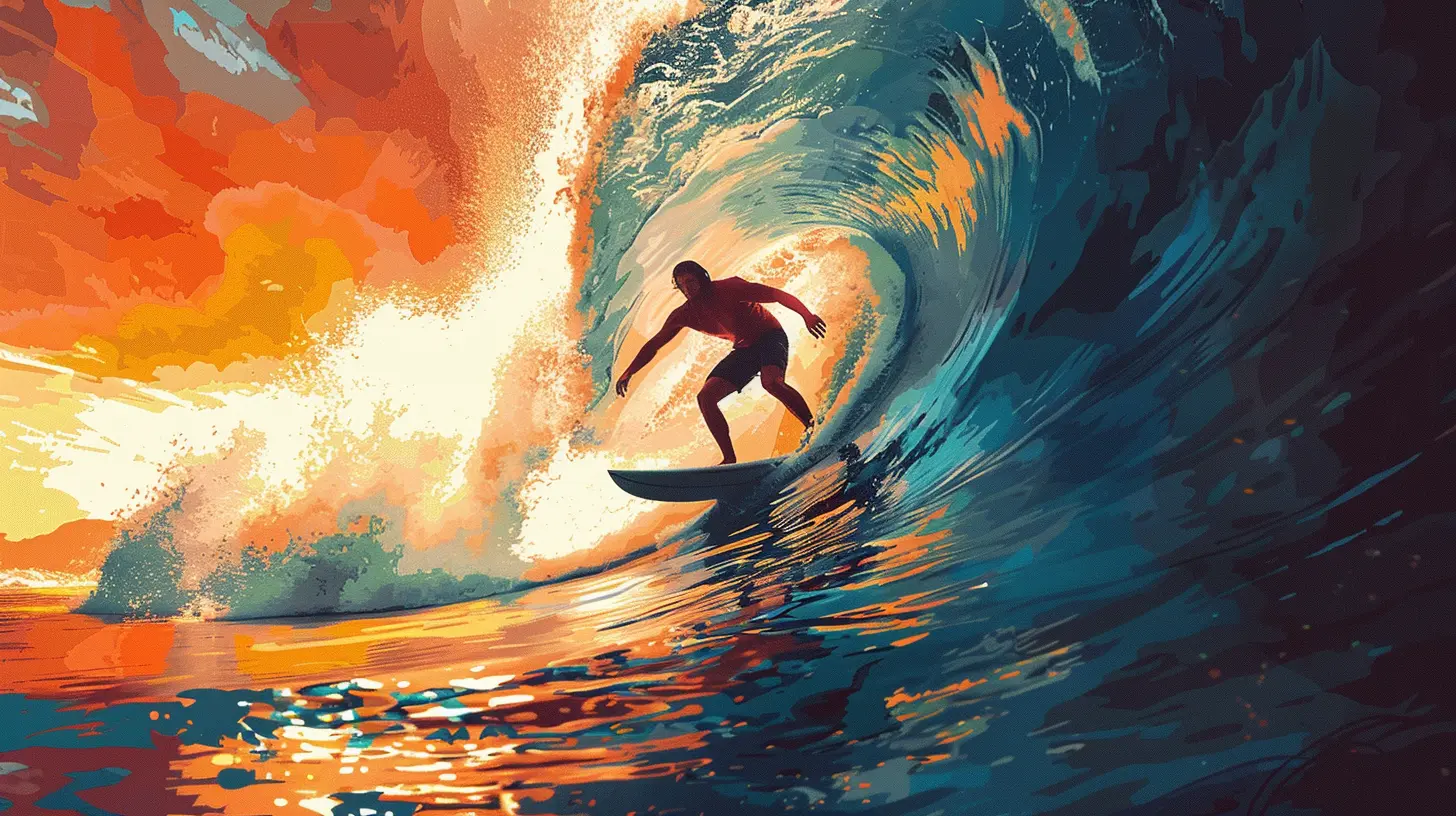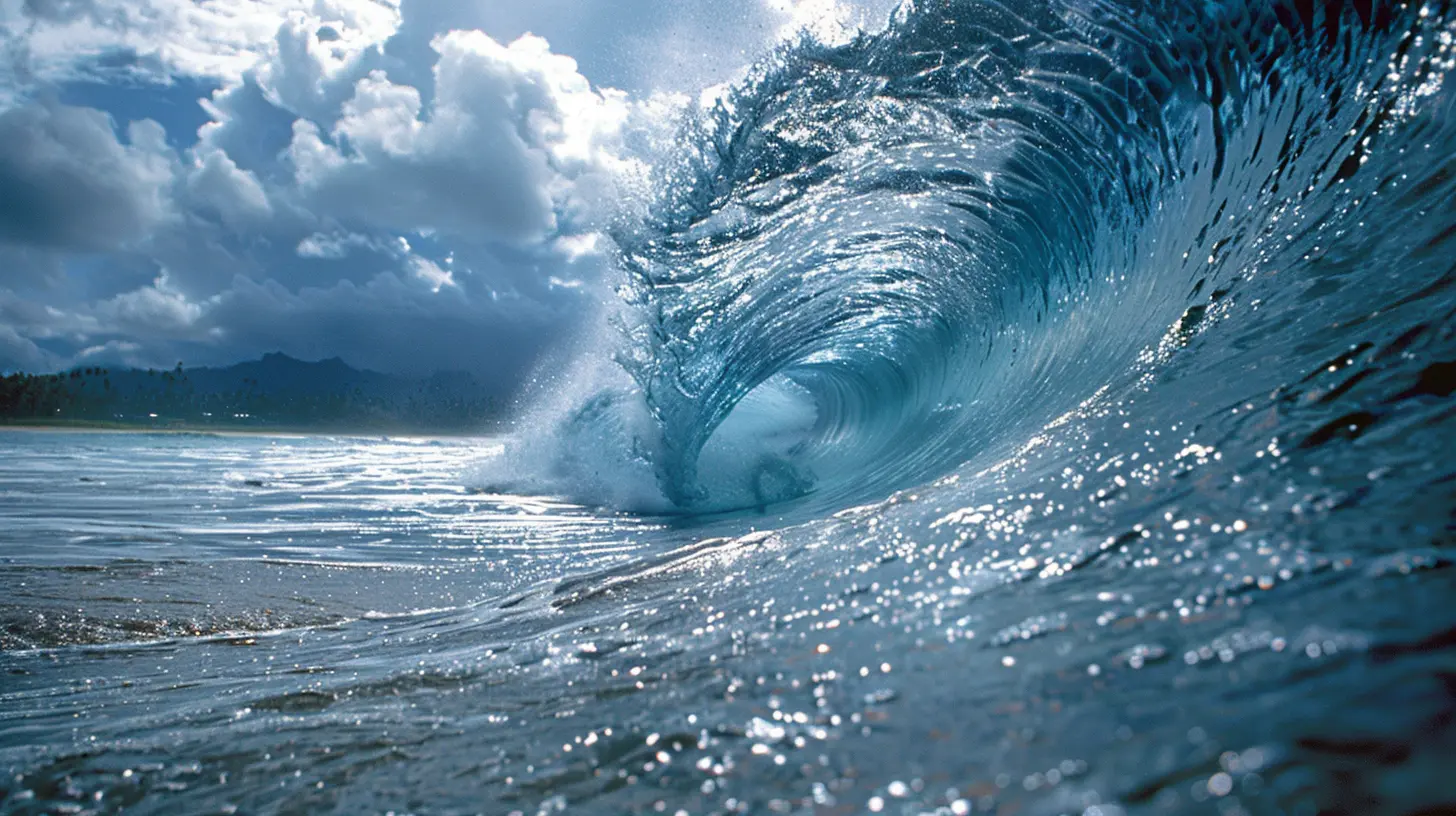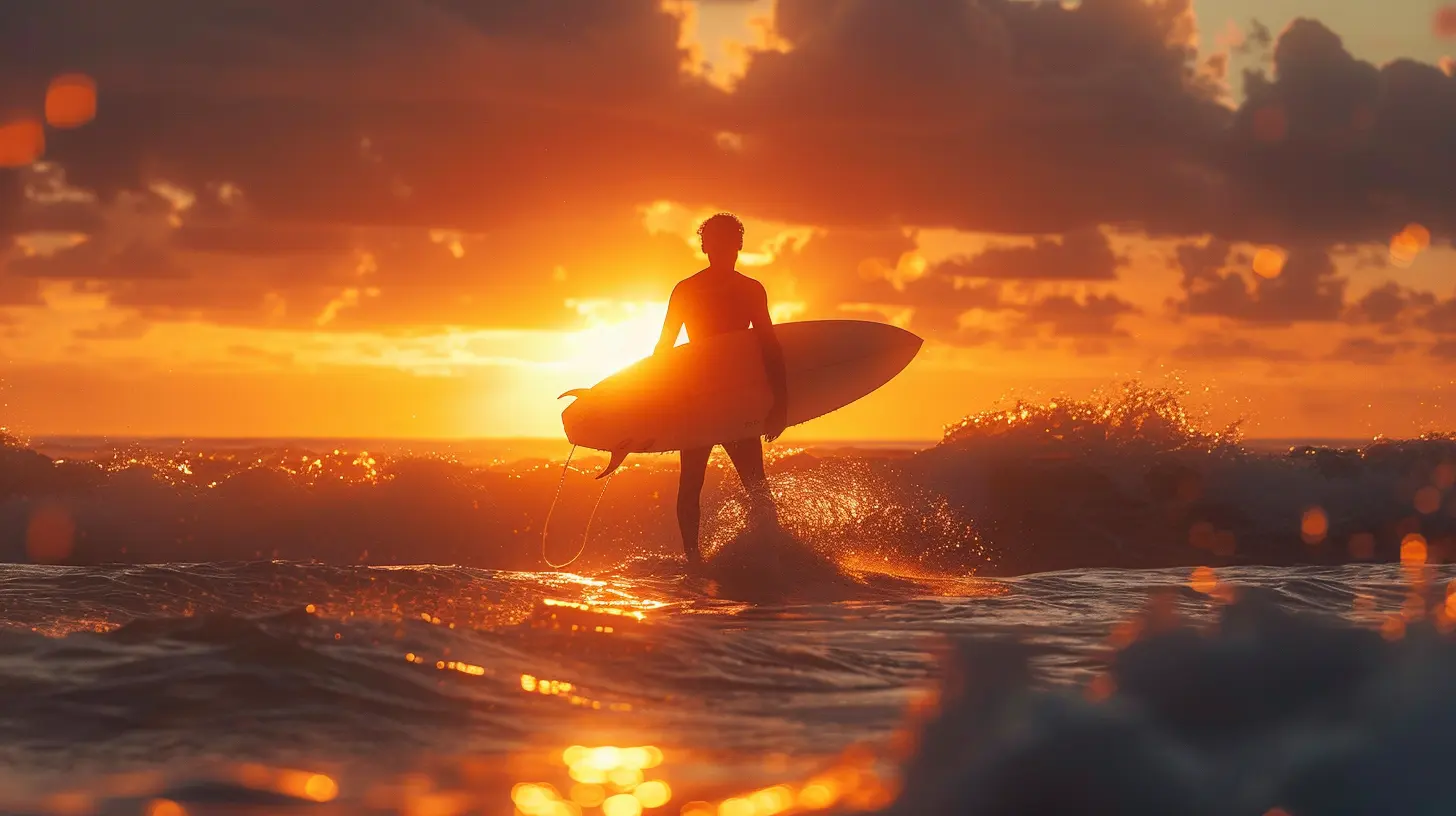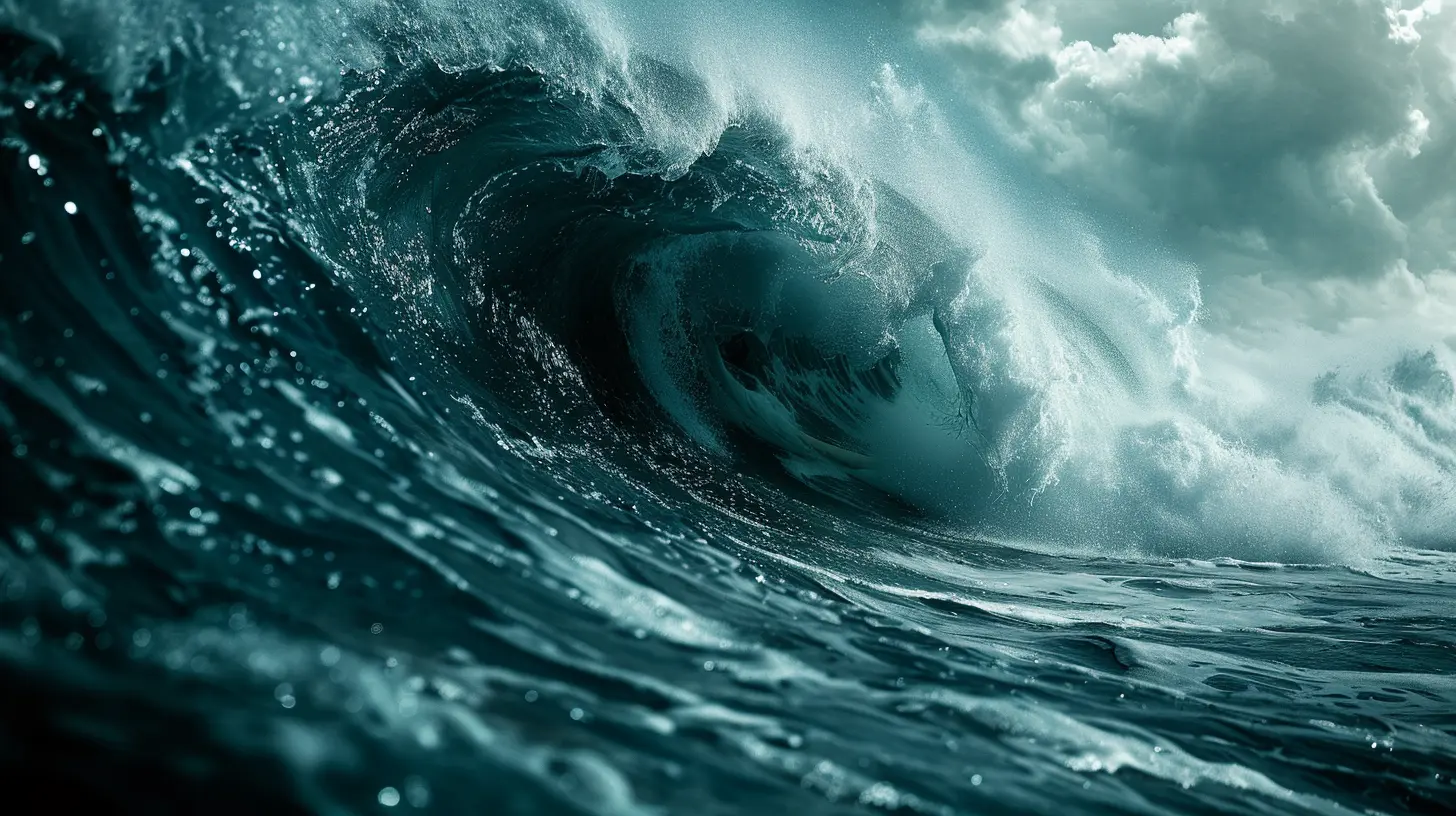The Impact of Climate Change on Surf Conditions
9 January 2025
When you think about surfing, what comes to mind? Blue skies, perfect waves, and the salty breeze cutting across your face as you glide effortlessly through the water. It’s a dream, right? But what if I told you that this dream might be on the verge of changing? Not because of your skill level or the board you’re riding, but because of something way bigger—climate change. Yep, the waves we ride, the beaches we love, and the ocean itself are all feeling the effects of our rapidly warming planet. Let’s dive in (pun intended) and explore the impact of climate change on surf conditions.

Rising Sea Levels: A Literal Game Changer
First things first, let’s talk about rising sea levels. You’ve probably heard this thrown around in conversations about climate change, but what does it mean for surfing? Well, the earth's temperature is increasing, ice caps are melting, and all that extra water is making its way into our oceans. Seems harmless, right? Not exactly.How it Affects Surf Spots
As sea levels rise, surf breaks that we’ve come to know and love are changing. Reef breaks, in particular, are highly sensitive to even the slightest shifts in water levels. When the water rises over a reef, the wave formation can become unstable, changing the way the wave breaks. What used to be a perfectly peeling wave might now turn into a mushy mess, or worse, disappear altogether. Imagine your favorite break no longer producing those epic rides—talk about a bummer!Even beach breaks aren’t immune. As the shorelines erode due to higher water levels, the underwater sandbars that create waves can shift. This can lead to less consistent wave patterns and fewer surfable days. In short, rising sea levels are messing with the very foundation of what makes a great surf spot.

Changing Ocean Temperatures: Hot and Bothered
Another major player in the climate change game is the rising temperature of our oceans. Water temperatures are going up, and that’s having a big impact on surf conditions.Impact on Wave Quality
Warmer water might sound like a dream for surfers who hate the cold, but it’s not all sunshine and rainbows. The increase in ocean temperatures is disrupting wind patterns and storm activity, which are key factors in creating the waves we ride. Typically, surfers rely on consistent wind patterns to generate swells. But with climate change, these patterns are becoming less predictable.Think about it like this: If you were baking a cake and someone kept turning the oven temperature up and down without warning, you’d end up with an uneven mess, right? That’s kind of what’s happening with our oceans. Consistent swells are becoming less frequent, and the waves that do come through might not be as clean or well-formed. It’s like the oven can’t decide on the right temperature, and surfers are left with unpredictable, less-than-stellar waves.
Coral Bleaching and Reef Breaks
Warming ocean temperatures are also wreaking havoc on coral reefs. Coral bleaching occurs when water temperatures rise above certain thresholds, stressing the coral and causing it to expel the algae that give it color and life. Bleached coral is essentially dead coral, and dead coral means the structure of reef breaks can deteriorate.Reef breaks rely on the solid, often sharp, underwater formations to create that perfect wave. If the coral dies off, those formations can collapse or erode, leading to less predictable and often less surfable waves. So, while you might enjoy the warmer water temps in the short term, the long-term effects could mean fewer quality reef breaks to surf on.

Storms and Swell Patterns: Too Much of a Good Thing?
Let’s talk storms. As climate change intensifies, so do storm systems. You might be thinking, “More storms? More waves, right?” Well, yes and no. While storms do generate the swells that create waves, too much storm activity can actually lead to less-than-ideal surf conditions.The Balance of Storms and Swells
Storms are like the engine that powers the ocean’s wave-making machine. But just like any machine, if it’s running too hot, things can go sideways. Stronger and more frequent storms can produce swells that are too large or chaotic for most surfers. Think about trying to paddle into a wave that’s 15 feet tall, closing out, and breaking in unpredictable directions—it’s not exactly the setup for a fun surf session.Not to mention, storms can also create choppy water conditions, making the ocean surface bumpy and difficult to navigate. It’s like trying to skate on gravel instead of smooth concrete—totally frustrating. So, while storms are necessary for creating waves, the increased intensity and frequency of storms due to climate change can lead to more days of unrideable surf.

Ocean Acidification: The Silent Threat
Here’s something you might not have thought about: ocean acidification. It’s not as flashy as rising sea levels or intense storms, but it’s just as important. As the ocean absorbs more carbon dioxide from the atmosphere, the water becomes more acidic. This process is happening slowly, but its effects are already being felt.Impact on Marine Life (And Surfing!)
Ocean acidification is bad news for marine life, especially the creatures that make up the ocean’s food chain. Shellfish, in particular, struggle in more acidic water because it makes it harder for them to build their shells. As these species decline, the entire marine ecosystem can become unbalanced.So, what does this have to do with surfing? Well, the health of the ocean's ecosystem plays a crucial role in maintaining healthy beaches and surf spots. If marine life is struggling, it can lead to changes in the coastal environment, which can, in turn, affect surf conditions. For example, the decline of certain species can lead to more algal blooms, which can make the water murkier and less appealing for surfers. Plus, a healthy ocean is just plain better for everyone, whether you’re surfing or not.
The Future of Surfing: Adapt or Wipeout?
Surfing has always been about adapting to the conditions. No two waves are exactly the same, and part of the thrill of the sport is figuring out how to ride whatever the ocean throws at you. But with climate change, the challenges are becoming bigger and harder to ignore.What Can Surfers Do?
So, where does that leave us? Is it all doom and gloom? Not necessarily. While the impact of climate change on surf conditions is real and significant, there are things we can do to help mitigate these effects. First and foremost, surfers can become advocates for the environment. After all, we have a vested interest in keeping our oceans and beaches healthy.Reducing our carbon footprint, supporting sustainable practices, and getting involved in environmental organizations are all steps we can take to protect the surf spots we love. Surfers are often at the forefront of environmental activism, and now more than ever, it’s important to use our voices to advocate for the planet.
The Role of Innovation
In addition to activism, innovation will also play a role in the future of surfing. Surfboard manufacturers are already exploring eco-friendly materials to reduce the environmental impact of board production. And wave pool technology is advancing, which could offer a solution for consistent surf conditions as the ocean becomes more unpredictable.Of course, nothing can replace the feeling of catching a wave in the ocean, but these innovations could help keep the stoke alive for future generations of surfers.
Conclusion: The Changing Tide
Climate change is a complex issue with far-reaching implications, and surfing is not immune to its effects. Rising sea levels, warmer ocean temperatures, and more intense storms are all changing the way we experience the ocean. But surfers are a resilient bunch. We’ve always adapted to the ever-changing nature of the sea, and now we’ll need to adapt to the changes brought on by a warming planet.At the end of the day, surfing is about more than just catching waves—it’s about a connection to the ocean and the environment. And if we want to keep riding waves for generations to come, we’ll need to step up and protect the very thing that makes surfing possible.
all images in this post were generated using AI tools
Category:
SurfingAuthor:

Easton Simmons
Discussion
rate this article
20 comments
Stacey McQuillan
Embracing the challenge of climate change can inspire surfers and communities alike to advocate for our oceans. Let's harness our passion for the waves to drive positive change and protect the future of surfing for generations to come!
March 30, 2025 at 4:38 AM

Easton Simmons
Absolutely! By uniting our love for surfing with climate action, we can create lasting change for our oceans and future generations of surfers.
Maren Alvarez
This article highlights an essential issue. Understanding how climate change affects surf conditions is crucial for both the sport and environmental advocacy. Thank you for shedding light on this important topic.
February 3, 2025 at 4:44 AM

Easton Simmons
Thank you for your insightful comment! I'm glad you found the article on this important topic valuable.
Marcus McHugh
Climate change isn’t just a distant threat; it’s reshaping our waves today. Let’s advocate for our oceans, protect our surf culture, and inspire positive change for future generations of surfers!
January 27, 2025 at 11:25 AM

Easton Simmons
Absolutely! Climate change is directly affecting our surf conditions and ocean health. It's crucial to advocate for sustainable practices to protect our waves and preserve surf culture for future generations.
Meagan Sheppard
Climate change reshapes our oceans, affecting surf conditions and coastal ecosystems. We must adapt and advocate for sustainable practices to protect them.
January 23, 2025 at 12:43 PM

Easton Simmons
Thank you for highlighting the crucial link between climate change and our oceans. Adapting and advocating for sustainable practices is essential to preserving surf conditions and coastal ecosystems.
Rocco Dodson
Climate change is significantly altering surf conditions worldwide. Rising ocean temperatures and shifting weather patterns contribute to unpredictable wave behavior and increased storm frequency. These changes pose challenges for both recreational surfers and professional competitions, demanding adaptive strategies to ensure the sustainability and safety of surfing environments.
January 19, 2025 at 7:51 PM

Easton Simmons
Thank you for highlighting the crucial impact of climate change on surf conditions. Indeed, as we adapt to these changes, it's essential for the surfing community to prioritize sustainability and safety in our practices.
Lisette Sharp
As surfers, we ride the waves of change! Let’s harness our passion to advocate for ocean health and climate action. Together, we can ensure future generations experience the thrill of surfing pristine breaks in a thriving, sustainable environment. Ride on!
January 19, 2025 at 5:11 AM

Easton Simmons
Absolutely! Riding the waves of change is essential for preserving our oceans and ensuring future generations can enjoy the surf. Let's advocate for a sustainable future together!
Fern McGee
This article compellingly highlights the urgent need for surfers to advocate for environmental sustainability, as climate change increasingly disrupts our beloved waves.
January 18, 2025 at 9:18 PM

Easton Simmons
Thank you for your insightful comment! It's crucial for surfers to champion environmental sustainability to protect our waves and oceans.
Lorna McNeil
Important issue affecting all surfers.
January 18, 2025 at 5:04 AM

Easton Simmons
Absolutely, it's a crucial topic that affects wave quality and ocean health for surfers everywhere.
Marcus Robinson
Surfing is not just a sport; it's a connection to nature. Let's protect our waves and planet. Together, we can ride the tide of change for a sustainable future in surfing!
January 17, 2025 at 1:49 PM

Easton Simmons
Absolutely! Surfing indeed embodies a deep connection to nature, and protecting our waves is essential for a sustainable future. Let’s unite for our oceans!
Corinne Bell
Surfing's essence clashes with climate change; our waves reflect our world's fate.
January 16, 2025 at 1:29 PM

Easton Simmons
Thank you for your insightful comment! You're right—surfing is deeply intertwined with our environment, and the changing climate significantly affects wave conditions. It's a crucial reminder of our responsibility to protect our oceans.
Chelsea McNaughton
Climate change dramatically alters surf conditions, affecting wave patterns and coastal ecosystems, challenging surfers' adaptability.
January 14, 2025 at 12:33 PM

Easton Simmons
Thank you for highlighting the connection between climate change and surf conditions. It’s crucial for surfers and coastal communities to adapt to these changes to protect both the sport and our ecosystems.
Courtney McDougal
Thank you for shedding light on such an important topic. The connection between climate change and surf conditions is often overlooked, yet it significantly affects both surfers and marine ecosystems. I appreciate your insights and hope this encourages more discussions around sustainability in our sport.
January 12, 2025 at 9:17 PM

Easton Simmons
Thank you for your thoughtful comment! I'm glad you found the insights valuable. It's crucial to raise awareness about these connections and foster discussions on sustainability in surfing.
Landon O'Brien
This article highlights a crucial yet often overlooked issue in sports. Climate change is reshaping surf conditions, affecting not just performance but also coastal ecosystems. It’s essential for surfers and the broader community to raise awareness and advocate for sustainability to protect our oceans.
January 12, 2025 at 1:33 PM

Easton Simmons
Thank you for highlighting this important issue! Addressing climate change is vital for preserving surf conditions and coastal ecosystems. Together, we can raise awareness and advocate for sustainable practices in our community.
Alexander McKenzie
This article highlights a crucial issue for surfers everywhere. It's essential to recognize how climate change affects our beloved waves and coastal ecosystems. By raising awareness, we can inspire action to protect our surf conditions for future generations. Well done!
January 12, 2025 at 3:42 AM

Easton Simmons
Thank you for your thoughtful comment! I appreciate your support in raising awareness about this important issue. Together, we can make a difference for our waves and ecosystems.
Brooks Mercado
Protect our planet to preserve our waves.
January 11, 2025 at 12:55 PM

Easton Simmons
Absolutely! Protecting our planet is crucial for maintaining healthy surf conditions. Every effort counts!
Katalina Wolfe
Climate change is reshaping surf conditions, altering wave patterns and water temperatures. As oceanic ecosystems struggle, surfers face unpredictable swells and declining surf quality. Addressing climate change is vital, not only for our waves but also for the health of our oceans.
January 11, 2025 at 5:27 AM

Easton Simmons
Absolutely, addressing climate change is crucial for maintaining both surf quality and ocean health. The ripple effects on our waves highlight the need for urgent action.
Alexander Riley
Climate change significantly alters surf conditions, affecting wave patterns and coastal ecosystems crucial for surfers.
January 10, 2025 at 11:25 AM

Easton Simmons
Thank you for highlighting this important aspect! Climate change indeed poses significant challenges to both surfers and coastal ecosystems, affecting wave patterns and marine life.
Kestrel McWhorter
Climate change isn't just a wave; it's rewriting the surf playbook one swell at a time.
January 9, 2025 at 8:26 PM

Easton Simmons
Absolutely! Climate change is profoundly altering surf conditions, reshaping our understanding of wave patterns and surfability. It's crucial for surfers to adapt and advocate for sustainable practices.
Maisie Kirkland
Urgent action needed to preserve waves.
January 9, 2025 at 1:58 PM

Easton Simmons
Absolutely! Protecting our waves is crucial for both the environment and the surfing community. Immediate action is essential to mitigate climate change impacts.
Valen Vaughn
This article raises fascinating points about the intersection of climate change and surfing! I’m eager to learn more about how shifting conditions might reshape our favorite surf spots in the future.
January 9, 2025 at 6:01 AM

Easton Simmons
Thank you! I'm glad you found it interesting. As conditions shift, we’ll likely see changes in wave patterns and sea levels that could redefine our beloved surf spots. Stay tuned for more insights!
MORE POSTS
![The Humble Beginnings of [Player Name]: From Dreamer to Dominator](/pictures/blog/small/the-humble-beginnings-of-player-name-from-dreamer-to-dominator_1.webp)
The Humble Beginnings of [Player Name]: From Dreamer to Dominator

The Most Surprising Player Trades of the Season

Surfing and Yoga: The Perfect Partnership for Balance

Exploring the Cultural Significance of Sports Documentaries

How to Overcome Shooting Slumps and Regain Confidence

The Science of Speed: What Makes an Olympic Sprinter So Fast?

Premier League Showdown: Who Will Triumph in the Next Big Derby?

The Science Behind Ski Wax and How to Choose the Right One

Why Mobility and Flexibility Are Crucial for Strength Training

The Power of Visualization: How Coaches Prepare Their Teams Mentally

The Mental Game: Developing Focus as an Amateur Athlete

Ski Racing Tips: How to Shave Seconds Off Your Time